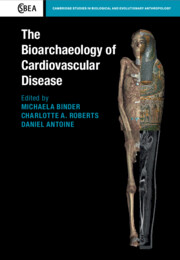Book contents
- The Bioarchaeology of Cardiovascular Disease
- Cambridge Studies in Biological and Evolutionary Anthropology
- The Bioarchaeology of Cardiovascular Disease
- Copyright page
- Dedication
- Contents
- Contributors
- Foreword
- Acknowledgements
- 1 The Bioarchaeology of Cardiovascular Disease
- 2 Exploring the Sources of Indirect Evidence for Cardiovascular Disease in Bioarchaeology
- Part I Evidence from Mummified Tissues
- Part II Cardiovascular Diseases Associated with Human Skeletal Remains
- 8 Calcified Structures as Potential Evidence of Atherosclerosis Associated with Human Skeletal Remains from Amara West, Nubia (1300–800 BCE)
- 9 Intracranial Atherosclerosis in Medieval Scandinavia
- 10 Abnormalities of the Vertebral Artery
- 11 A Heart of Stone
- 12 ‘Absence of Evidence Is Not Evidence of Absence’
- Part III Contemporary Perspectives
- Index
- References
10 - Abnormalities of the Vertebral Artery
Are Cervical Pressure Defects Being Overlooked in Palaeopathology?
from Part II - Cardiovascular Diseases Associated with Human Skeletal Remains
Published online by Cambridge University Press: 31 March 2023
- The Bioarchaeology of Cardiovascular Disease
- Cambridge Studies in Biological and Evolutionary Anthropology
- The Bioarchaeology of Cardiovascular Disease
- Copyright page
- Dedication
- Contents
- Contributors
- Foreword
- Acknowledgements
- 1 The Bioarchaeology of Cardiovascular Disease
- 2 Exploring the Sources of Indirect Evidence for Cardiovascular Disease in Bioarchaeology
- Part I Evidence from Mummified Tissues
- Part II Cardiovascular Diseases Associated with Human Skeletal Remains
- 8 Calcified Structures as Potential Evidence of Atherosclerosis Associated with Human Skeletal Remains from Amara West, Nubia (1300–800 BCE)
- 9 Intracranial Atherosclerosis in Medieval Scandinavia
- 10 Abnormalities of the Vertebral Artery
- 11 A Heart of Stone
- 12 ‘Absence of Evidence Is Not Evidence of Absence’
- Part III Contemporary Perspectives
- Index
- References
Summary
The vascular system, as it passes through grooves and foramina along the surfaces of bones, can leave impressions on the skeleton. The areas where bones and vessels come into close contact can allow palaeopathologists to investigate vascular variations and pathological changes long after the loss of any soft tissues. For example, abdominal (Diekerhof et al., 2002; Ando et al., 2003) and thoracic (Sheeran & Sclafani, 2000; Takahashi et al., 2007) aneurysms can lead to lesions on the vertebrae.
- Type
- Chapter
- Information
- The Bioarchaeology of Cardiovascular Disease , pp. 174 - 201Publisher: Cambridge University PressPrint publication year: 2023

